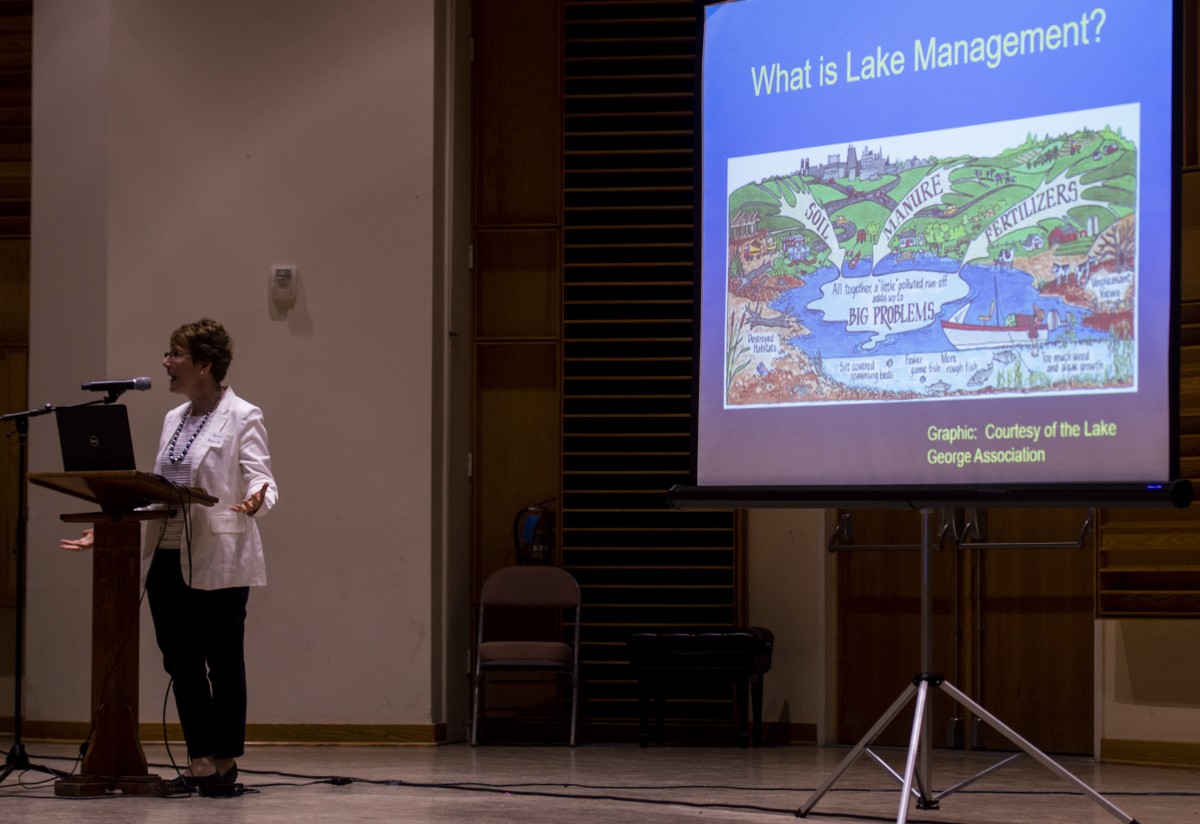More than a hundred community members gathered on Saturday, June 15, ahead of the summer season at the first Chautauqua Lake Conference to learn more about weeds, algae and land use as they relate to the lake.
The event was the first of its kind for Chautauqua County, and is part of a renewed effort for collaboration among lake stakeholders after last year’s — sometimes heated — disagreements about herbicides.
It also comes a little more than a month after over a dozen municipalities and organizations signed a Memorandum of Agreement titled “Chautauqua Lake Weed Management Consensus Strategy.”
“I don’t have a magic wand,” said Nancy Mueller, manager of the New York State Federation of Lake Associations, about improving the health of the lake. “It’s going to be very challenging and it’s probably never going to end. Taking care of this lake will be around for as long as people are here and as long as the lake is here.”
The conference was held in Elizabeth S. Lenna, Fletcher and McKnight Halls, and featured talks by aquatic ecologists, directors of lake associations and other local dignitaries.
Lecture topics addressed weeds and algae, the largest issues that face the health of Chautauqua Lake.
In one of the conference’s breakout sessions, Courtney Wigdahl-Perry, a biology professor at the State University of New York at Fredonia, discussed harmful algal blooms. These occur when colonies of algae grow out of control. They are a common problem in the lake, especially the southern basin, and especially during the months of July and August.
HABs can be toxic to people, birds and aquatic creatures. They can also decrease oxygen levels where the algae is present in the lake, which is dangerous for aquatic animals. Despite the presence of HABs later in the season, most of the lake can still be used by people for recreation.
However, Wigdahl-Perry stressed that normal levels of algae are a crucial part of a healthy lake ecosystem.
“If we have no algae, we have no world-class fisheries here,” she said. “Algae are the entrance point for energy that feed the zooplankton, and that feeds the fish.”
Event organizer Jeanne Wiebenga said the goal of the conference was to “bring people who were not really seeing eye-to-eye or talking to each other together and use a science-based approach to ideally come up with a set of best management practices for the lake.”
“I can’t say that’s what we achieved, but we got a little closer to it,” she said.

Disagreements about the best way to take care of the lake flared last year over whether herbicides should be used to treat invasive weed problems in the southern basin.
On July 30, 2018, Chautauqua Institution filed a petition contending that the Chautauqua Lake Supplemental Environmental Impact Statement (SEIS) prepared by the Town of Ellery did not properly address questions about the safety of herbicides with respect to people and the environment.
The suit was dismissed in the state Supreme Court in Erie County, in December because it was filed “too late and moot with respect to the 2018 administrative process for herbicide permits and too early for any yet to be filed permit applications for 2019,” the ruling read.
The Memorandum of Agreement that lake stakeholders signed includes a provision that prohibits them from suing one another.
At the conference, Chautauqua County Executive George Borrello, who spearheaded the memorandum, commended Institution President Michael E. Hill for being the first to sign the agreement.
“For me, as county executive, with a very tight budget, I don’t want to see any taxpayer dollars going to support lawsuits,” Borrello said. “I certainly don’t want to see any more of the negativity that reflects poorly on all of us. I also did not want to see the continued degradation of our lake.”
A few days after the conference, Hill said he thought the event encouraged civil dialogue among representatives from a variety of viewpoints about what should be done to improve the health of the lake.
In the past, Hill said he has observed groups deciding on a method to improve conditions in the lake and retroactively finding science to support that method.
“I hope that we can create a mechanism to bring comprehensive science to the lake,” he said. “I hope that we can look holistically at the issues, including the watershed, and make important decisions.”
Hill pointed to the Jefferson Project at Lake George, which employs scientists year-round to study the lake, as an example of the type of scientific research he hopes to see here in Chautauqua County.
Wiebenga, who is also a co-vice president of the Chautauqua Watershed Conservancy, said organizing the conference helped to bring people together, since the planning process involved representatives from a number of organizations, including the Conservancy, the Chautauqua Lake Partnership and the Chautauqua Lake Association.
“This is not the end,” she said. “At least now, we talk to each other a lot better than two years ago.”








